NEWS & EVENTS

NEWS & EVENTS

Two new subway lines designed by UCD opened in Beijing
On December 28, along with the new pricing system for subway and bus traffic, the 2nd phase of Beijing Subway Line 6 and the eastern section of Beijing Subway Line 14 designed by Beijing Urban Construction Design & Development Group (short for UCD hereinafter) through a project package were officially open to traffic. Subway Line 7 and the western section of the 1st phase of Subway Line 15 were also put into operation at the same time. The four new lines extend Beijing’s rail traffic milage to 527 kilometers in total.
The five-year period from 2010 to 2014 is the heyday for the opening of Beijing subway lines designed by UCD. Five subway lines, with a total length of 139.95km, namely, the 1st phase of Changping Line, Subway Line 9, the 2nd phase of Subway Line 10, the 1st and 2nd phases of Subway Line 6 and the western and eastern sections of Subway Line 14, were opened during the period with an annual operation length extension of 27.99 km in average. The development fully shows UCD’s design strength and technical level, makes important contribution to the rapid extension of Beijing subway network, and lays a solid foundation for UCD’s leading technology and market advantages in Beijing.
The highlights, characteristics and difficulties in the projects of the 2nd phase of Beijing Subway Line 6 and the eastern section of Beijing Subway Line 14 are introduced as follows.
I.Profile of Subway Line 14
Subway Line 14 is Beijing’s first line with the six-car-marshallingType-A Train.
Subway Line 14 is scheduled to open in three stages for the western, eastern and middle sections respectively. The western section was open to pilot traffic on May 5, 2013. The eastern section, with a full length of 14.5km, are completely underground with 12 underground stations, i.e., Jintailu, Chaoyang Park, Zaoying, Dongfeng Beiqiao, Jiangtai, Gaojiayuan, Wangjingnan, Futong, Wangjing, Donghuqu, Laiguangying, and Shangezhuang. When putting into operation at the end of 2014, trains will stop at aforesaid 11 stations except Gaojiayuan. The Maquanying Car Depot will be put into operation with the eastern section of Line 14.
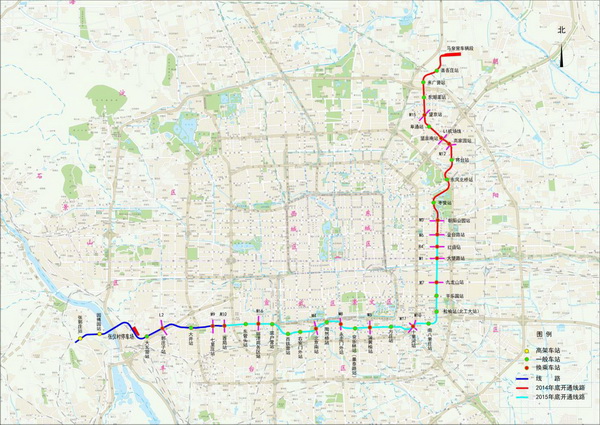
Line 14 is China’s first line with the Type A stainless steel trains. Based on the inheritance of successes in existing lines, we made bold sci-tech innovations in the design.The first application of continuous construction segments for single circle large-diameter dual-line shield tunnel, and the brand-new construction through enlarging shield tunnel combined with cut-and-cover method, broadened the idea for the follow-up work. MV inversion-type recycle power utilization equipment are applied at all stations with traction power substations for the first time to save energy and electricity. The demonstration of scientific research project Application of Comprehensive Energy Saving Technology through Cancellation of the Ground Cooling Towers was made at Futong Station. The application of new subway logo and 3D map system improved human-centered services. The research and implementation of new technologies and facilities offered important technical reserve and support for the follow-up linking lines in the subway system.
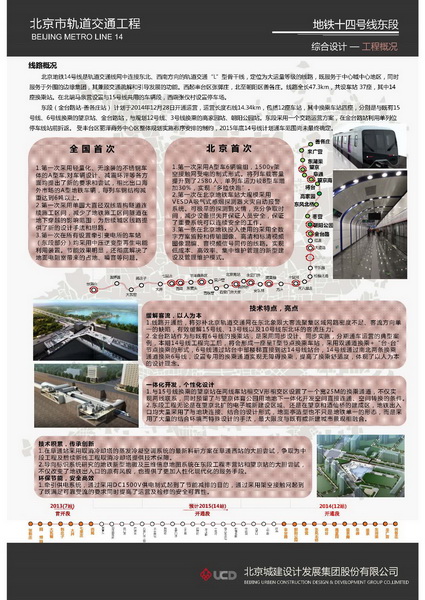
II. Profile of Subway Line 6
Starting from Wuluju Station in the west and ending at Qiushiyuan Station (Dongxiaoyuan Station), Beijing Subway Line 6, with a full length of 42.75km, is mainly built along the Linglong Road, West Chegongzhuang Road, Chegongzhuang Street, West Ping’anli Street, West Di’anmen Street, East Di’anmen Street, Beiheyan Street, Dongsi West Street, Chaoyangmennei Street, Chaoyangmengwai Street, North Chaoyang Road, Tongzhou Beiguan Street, Bihe Road and Yunhe East Street. The line crosses some water systems, including the Beijing-Miyun Diverge Channel (east to Cishousi Station), the Beihai Lake(east to the National Liberary), the Er’daogou Branch (south to the road between Jintailu and Xinghuolu stations), the Tonghui River (between Beiguang Huandao and Tongyunmen stations) , the Northern Canal (the lower reach of the Wenyu River, between Yunhe West Station (Yudaihe Street Station) and Haojiafu Station).
Line 6 has 29 stations (originally 27 stations, and then add two more stations according to the plan adjustment, one station not to be opened in the near future). The station interval measures1,573 meters in average, and 4,001 meters for the longest, 845 meters for the shortest.

The sketch map of Subway Line 6 upon the completion of the 2nd phase project
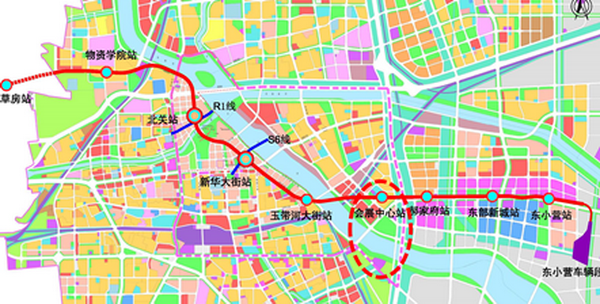
The sketch map of the 2nd phase project of Subway Line 6
(1)Integrated and simultaneous development of Beijing subway system and peripheral underground areas
The corridors linking subway stations and peripheral underground sites were rather long in the original Beijing subway system.
The first attempt for zero-distance linking was made in connecting Olympic Green Subway Station and its peripheral underground sites, thus setting up the rudimental mode for integrated design and development of subway stations and peripheral commercial sites. In the new lines built after the project, more attempts for integrated design and development were made at the Liuliqiao, Changying and Huaxiang stations.
With the plan and development of the Tongzhou New Town, the concept of high-intensity development and zero-distance linking was introduced in the project planning period. Thus, the core areas Beiguan and Xinhua Street development zones came into shape through the combination of the ground buildings with the underground subway station-centered business clusters. It is the largest integrated development in Beijing’s subway history . The report “To realize value together” elaborates the development process.
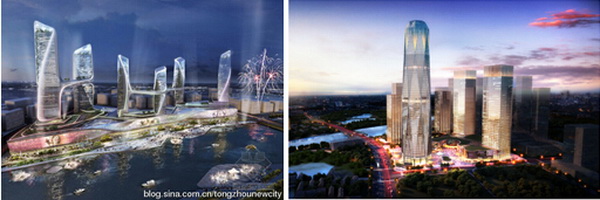
Several real estate projects involved in the integrated design and development of the subway stations
(2)The first atrium stations for rail traffic in Beijing
In Nanjing, Wuhan and Xi’an, the upper and lower floors of some major subway stations are partly connected through removing the middle layer to form a big atrium and change the tedious two-floor structure.

Atrium metro stations in Shanghai, Nanjing and Wuhan
The new-round large-scale subway development was carried out in the first decade of the 21st century to solve the urgent problem of urban traffic congestion. To meet the high fire design standards, reliable and prudent station construction was carried out, and the characteristic atrium station design was not introduced to Beijing. The standard “two-floor, three-span rectangular” design was widely applied and spread in Beijing’s subway station design based on the fixed relations between the hall and the space, between the width and the height. The stations for different subway lines only have slight differences in decorations. The appearance of stations is rather monotonous.
During the design of the 2nd phase of Subway Line 6, in combination with the opportunity of forging Tongzhou New Town as a sub-center of Beijing and under the guidance of the planning concept of “urban lobby,” the owners and the companies for holistic design, building design, equipment and decoration design and construction worked closely to overcome difficulties. By means of new design for fire performance optimization, the difficulties in the station design were solved. Three atrium stations, namely Tongzhou (Beiguan), Tongyunmen(Xinhua Street) and Yunhe West Station(Yudaihe Street), were set up and compliant with the high fire standard of Beijing.
The three stations are different and impressive in atrium design. At the Beiguan Station, the dark column base, the white floor, column body and ceiling show a modern architectural style with intense contrast of black and white. At the Xinhua Street Station, the large concrete-made Y-shape columns and lofty atrium are impressive. At the Yudaihe Station, the natural lighting is applied in the design.
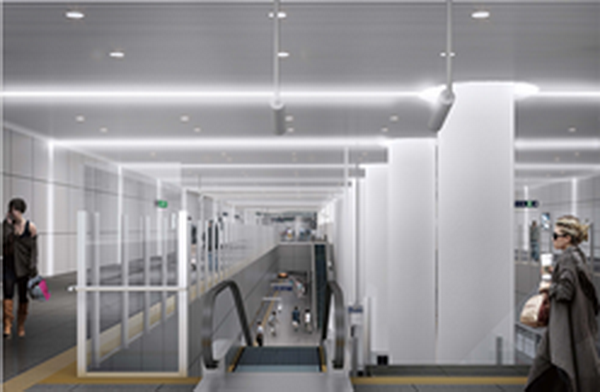
The atrium effect picture of Tongzhou Station (Beiguan Station)
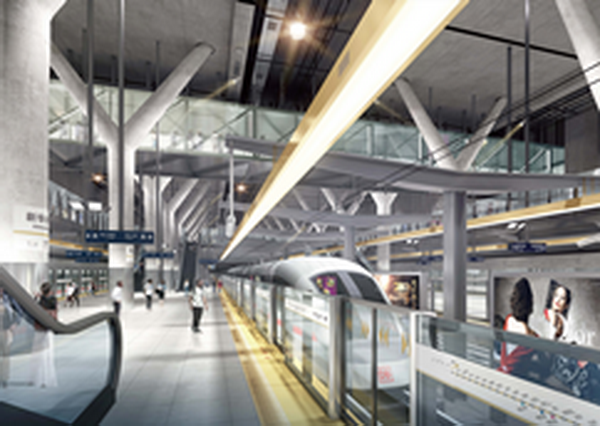
The atrium effect picture of Tongyunmen Station (Xinhua Street Station)
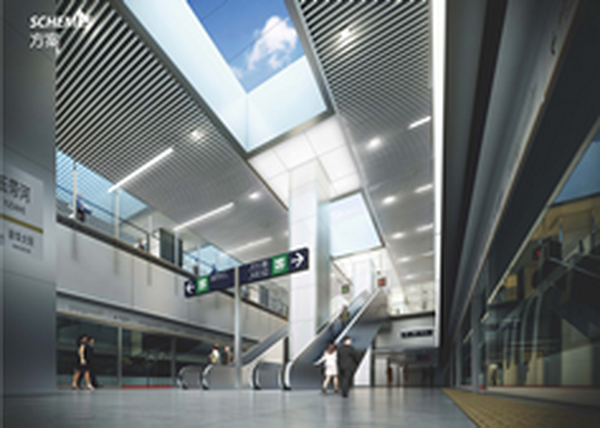
The atrium effect picture of Yunhe West Station (Yudaihe Street Station)
(3) Beijing’s 1st subway station with skylights
Of the aforesaid three atrium stations, the Yunhe West Station (Yudaihe Street Station) enjoys the best geological conditions. The underground station is situated at the development zone with the pedestrian street and urban green land on its roof. So, skylights are built in the station. The golden sunshine shines in the platform through the skylights. The passengers are exempted from the underground oppression and depression at the first skylight subway station in Beijing.
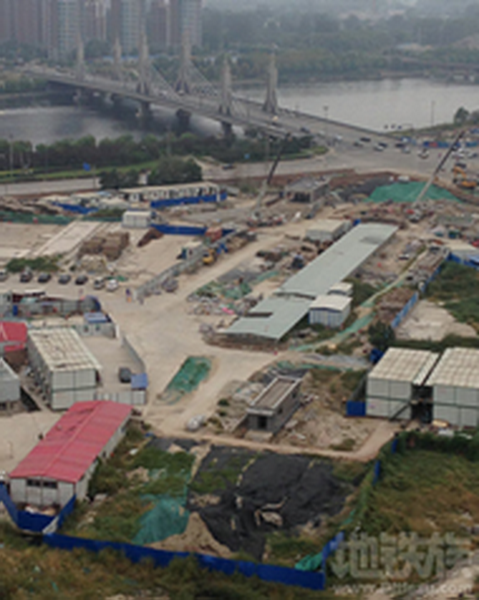
Workers are installing skylights at the Yunhe West Station (Yudaihe Street Station).